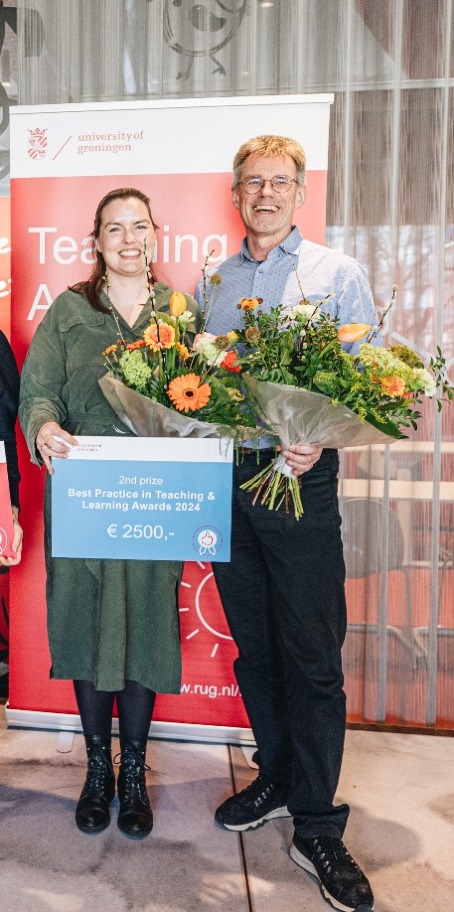Less relaying and more discussion in ‘Geographies of the United States’

In New Ways of Teaching, professors share their innovative, creative, and effective teaching initiatives. From unusual teaching methods to new technologies—anything is possible. How do these ideas arise and how do they impact students? This month: Students jump in the deep end in Geographies of the US.

At the start of this year, Dr Peter Groote, associate professor of Cultural Geography, and Dr Leonieke Bolderman, assistant professor of Cultural Geography, won second place in the Best Practice Awards in Teaching & Learning for their innovative course unit ‘Geographies of the United States’. This course unit has no lectures, seminars, or standard course literature. Instead of continuously having to pay attention to their lecturers, the students actually do the majority of the work themselves.
‘Let the customer do the work’
Instead of regular classes and self-study, students complete interactive assignments such as the so-called Pecha Kucha presentations, annotated videos, research projects, and meetings with experts. Our goal is to reduce the amount of information relayed to students, allowing them to do and experience more. We have noticed that the assignments we give them create a better sense of involvement among students than traditional self-study. This applies to the involvement among students as well as with the lecturers and the course material.
Visual interaction
Already from the start of the course, students do much more themselves compared to the average course unit. In the second week of class, for example, students are already giving presentations in the ‘Pecha Kucha’ format: slides switch after a set amount of time (in our case, 30 seconds) and may only show visual material, without text and bullet points. To prepare for these presentations, students watch videos instead of reading books or articles. These can be found in Feedbackfruits, an interactive video tool, where students and lecturers can leave comments and respond to one another. We have noticed that students are much more engaged with the material compared to traditional self-study. The students’ midterms are also based on the material presented in these videos.
Less stress, more informality
The most beloved part of this course unit is the three to four master classes we offer each year. These are taught by guest speakers who have a lot of experience in relation to the United States (unsurprisingly, these are often Americans) about a topic of choice. These classes are not necessarily lectures, but rather interactive sessions in which students hear personal accounts of what it is like to live, work, and go to college in the US. These masterclasses are not part of the assessment, so students can feel less stress about having to remember the material and can participate in a conversation or discussion with the guest speaker instead. Students are generally content with the mode of assessment because it consists of multiple smaller assignments, which results in less stress than one big final exam, for example.
Born out of necessity
Long ago, we were instructed to set up this course in a really short time span, which is how this design came to be. We did not have time to set up lengthy lectures. The course unit’s unique concept was actually born out of necessity, but that did not affect the students’ positive experience.
More importantly, we are convinced that for a course unit such as ‘Geographies of the US’, simply relaying a lot of information does not benefit students’ understanding of the material. We think it is important that students can experience the course topic, in this case US society, as engagingly as possible. Interactive master classes, videos, and doing their own research projects are important steps toward achieving that engagement. We have noticed that students are much more active from the start of the course, albeit more or less out of necessity. They appreciate the freedom and the active role they are given, even though many students have to get used to it at first. For us lecturers, the most important outcome of these teaching methods is that the course unit has shown to provide better retention. Students remember certain elements of the material for a much longer period of time, rather than merely until the final exam.
Two birds with one stone
Not only our students take something away from this course unit, but we as lecturers also learn something new each year as well. The master classes are different each year, students research different topics for their research projects, and new students offer new insights into the discussions about the videos. This gives us an interesting new learning experience each year as well. But we benefit most from being more engaged with the students’ learning process and the activities they partake in. A close-knit relationship with your students makes teaching much more personal and exciting.
More information
-
Read other editions of New Ways of Teaching
| Last modified: | 16 October 2024 12.17 p.m. |
More news
-
24 March 2025
UG 28th in World's Most International Universities 2025 rankings
The University of Groningen has been ranked 28th in the World's Most International Universities 2025 by Times Higher Education. With this, the UG leaves behind institutions such as MIT and Harvard. The 28th place marks an increase of five places: in...
-
05 March 2025
Women in Science
The UG celebrates International Women’s Day with a special photo series: Women in Science.
-
16 December 2024
Jouke de Vries: ‘The University will have to be flexible’
2024 was a festive year for the University of Groningen. In this podcast, Jouke de Vries, the chair of the Executive Board, looks back.
